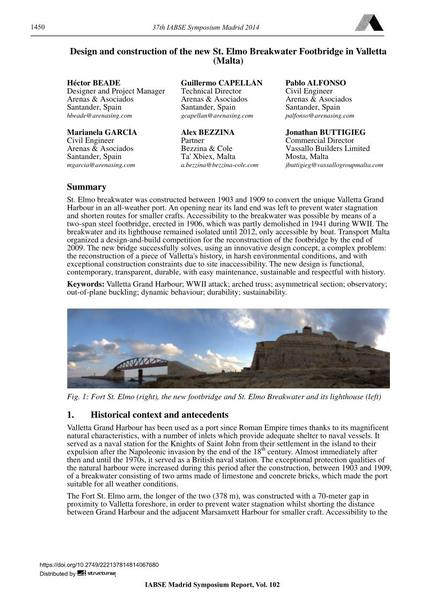Design and construction of the new St. Elmo Breakwater Footbridge in Valletta (Malta)

|
|
|||||||||||
Bibliographic Details
| Author(s): |
Hector Beade
Guillermo Capellán Pablo Alfonso Marianela García Alex Bezzina Jonathan Buttigieg |
||||
|---|---|---|---|---|---|
| Medium: | conference paper | ||||
| Language(s): | English | ||||
| Conference: | IABSE Symposium: Engineering for Progress, Nature and People, Madrid, Spain, 3-5 September 2014 | ||||
| Published in: | IABSE Symposium Madrid 2014 | ||||
|
|||||
| Page(s): | 1450-1458 | ||||
| Total no. of pages: | 9 | ||||
| Year: | 2014 | ||||
| DOI: | 10.2749/222137814814067680 | ||||
| Abstract: |
St. Elmo breakwater was constructed between 1903 and 1909 to convert the unique Valletta Grand Harbour in an all-weather port. An opening near its land end was left to prevent water stagnation and shorten routes for smaller crafts. Accessibility to the breakwater was possible by means of a two-span steel footbridge, erected in 1906, which was partly demolished in 1941 during WWII. The breakwater and its lighthouse remained isolated until 2012, only accessible by boat. Transport Malta organized a design-and-build competition for the reconstruction of the footbridge by the end of 2009. The new bridge successfully solves, using an innovative design concept, a complex problem: the reconstruction of a piece of Valletta's history, in harsh environmental conditions, and with exceptional construction constraints due to site inaccessibility. The new design is functional, contemporary, transparent, durable, with easy maintenance, sustainable and respectful with history. |
||||
| Keywords: |
sustainability durability dynamic behavior Valletta Grand Harbour WWII attack arched truss asymmetrical section observatory out-of-plane buckling
|
||||
